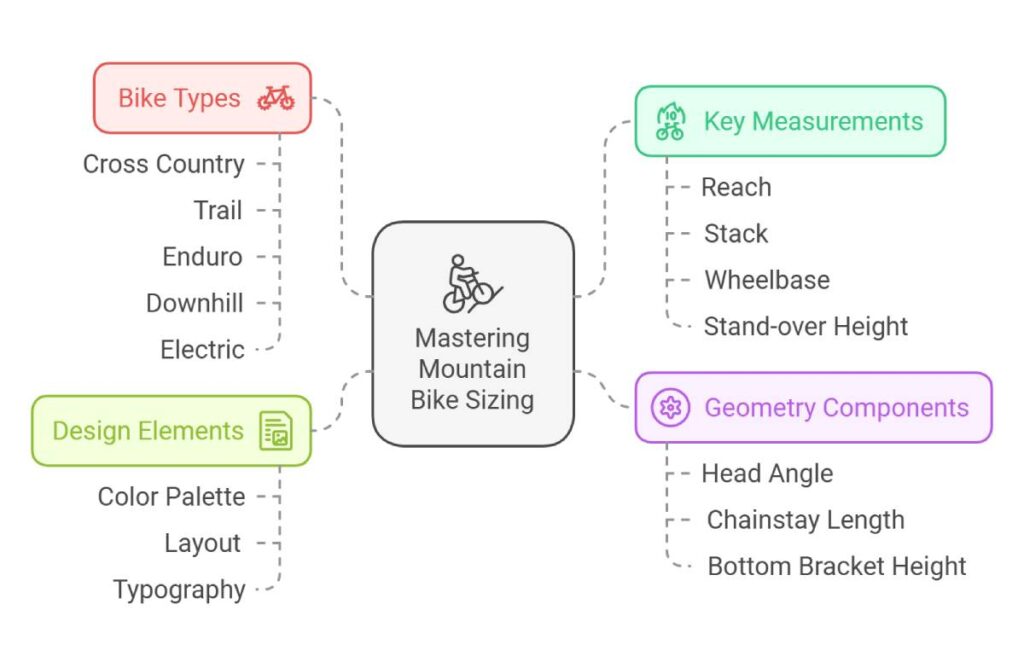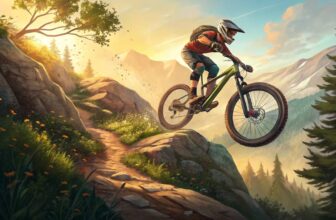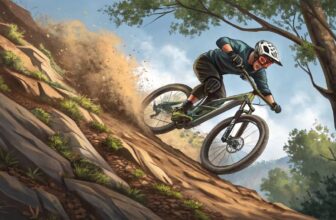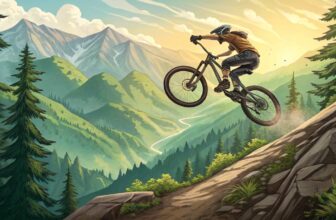Embarking on a mountain biking adventure starts with the perfect fit. Imagine gliding effortlessly down rugged trails, every pedal stroke harmonized with your bike’s geometry.
Whether you’re a seasoned rider or just gearing up, understanding mountain bike sizing is your ticket to unmatched comfort and control.
Dive into the essentials of reach, stack, wheelbase, and more, and discover how the right size can transform your riding experience.
Let’s navigate the path to finding your ideal mountain bike, ensuring every trail ride is smooth, confident, and exhilarating.
Understanding Mountain Bike Sizing
Picking the right mountain bike size isn’t just about looks; it’s about comfort, control, and zooming down those trails with confidence. Here’s a peek into the vital bits like reach, stack, wheelbase, and stand-over height to nail down your ideal ride.
Reach and Stack Measurements
Reach has nothing to do with stretching your arms. It’s actually about the horizontal distance from where your feet spin the pedals to where your hands grab the handlebars. Get it right, and you’ll have the perfect posture.
A longer reach gives you more wiggle room and keeps you from looking like a folded-up lawn chair. On the flip side, a shorter reach has you sitting more upright—perfect if you’re blessed with long legs or you’re about as bendy as a plank.
Stack is the vertical cousin of reach, measuring from where your feet spin to the roof of the handlebars. This one doesn’t shift as much between sizes but makes sure you’re not stuck riding a bike that feels like doing yoga in a phone booth.
| Size | Reach (mm) | Stack (mm) |
|---|---|---|
| Small | 425 | 600 |
| Medium | 450 | 615 |
| Large | 475 | 630 |
Source: Evo
Wheelbase and Stand-over Height
Wheelbase might sound fancy, but it’s all about the distance between your bike’s front and back wheels. Less means nimbler moves, great for dodging unexpected squirrel appearances. More means you’re steady as a rock at speed, which is handy if you’re speeding downhill and want to feel like King of the Mountain.
Stand-over height is the space between the top tube and the ground when you’re not riding. Enough clearance here means you’re not going to squish anything vital when you stop suddenly. Lower stand-over heights boost your confidence, especially if you’re just starting out or in between frame sizes. Get the lowdown on frame sizes with our handy mountain bike frame sizes.
| Size | Wheelbase (mm) | Stand-over Height (cm) |
|---|---|---|
| Small | 1100 | 75 |
| Medium | 1130 | 80 |
| Large | 1160 | 85 |
Source: Evo
If you’re looking for more nuggets of wisdom on getting comfy on your ride, check out our mountain bike frame sizes guide or learn mountain biking basic skills.
Picking the right mountain bike is like assembling a puzzle—reach, stack, wheelbase, and stand-over height need to click together. For more help, mosey on over to our advice on choosing the right size and discover the top mountain bike picks for rookies.

Key Geometry Components
Getting under the hood of mountain bike geometry can seriously change the way you ride. We’re talking three big players here: head angle, chainstay length, and bottom bracket height.

Head Angle Importance
The head angle, the bit between your bike’s front fork and the ground, shapes up how your bike dances on the dirt. A slacker head angle, hovering around 65°, is your buddy for stable cruising at high speeds, perfect for when you’re pointing downhill and want a comfy ride. But a steeper angle, say 70°, gives you a handle on precision steering—a must-have for conquering those uphill grinds.
| Head Angle | Where It Works Best | Stability | Steering Control |
|---|---|---|---|
| 65° (Slack) | Downhill Rockets | High | Moderate |
| 70° (Steep) | Mountain Climbs | Moderate | High |
Picking a slack or steep angle boils down to your trail story and style. Want more tips? Check out our piece on mtb suspension setup.
Chainstay Length Consideration
Chainstay length, the space from the bottom bracket to the rear axle, is all about your bike’s spryness and balance. Short chainstays let you shift weight like a ninja, making those manuals and wheelies a breeze. They bring a lively, fun vibe, great for trails and tricky ascents.
But if you’re after speed steadiness and climbing grip, longer chainstays have your back, especially suited for cross-country tracks. Your perfect length? That’s your call based on what thrills you. Need a nudge on bikes? Peek at our guide on the best mountain bikes under 1000.
Bottom Bracket Height Impact
Bottom bracket height, the gap between the ground and the crank’s heart, dictates how your bike corners and slides through turns. Lower brackets mean your bike hugs corners like a tight-knit buddy—a thrill for downhill and enduro bikers where swift and sturdy turns are the name of the game.
| Bottom Bracket Height | Cornering Confidence | Ride Feel |
|---|---|---|
| Low | High | Seamless |
| High | Moderate | Agile |
Get your bottom bracket just right, and your bike’s gonna purr through your usual routes. Think this is interesting? Hop over to our article on mtb bottom bracket types.
Knowing these geometry pieces means you’re set to decide wisely about bike size and fit with your biking style. Explore more about mountain bike frame sizes and other tweaks to make your biking groove just right.
Types of Mountain Bikes
Picking the right mountain bike isn’t just a matter of getting from Point A to Point B; it’s about the ride. Dive into these categories to find your perfect match for fun and performance.
Cross Country Bikes
Cross country bikes are your go-to for zippy rides across long trails. Picture a lightweight frame that slices through air combined with a geometry that begs you to sprint up hills. They’re built for those who live for that heart-pounding, fast-paced ride.
| Feature | Specification |
|---|---|
| Suspension Travel | 80mm – 120mm |
| Frame Material | Carbon or Aluminum |
| Wheel Size | 29 inches |
| Primary Use | Race and Fitness |
Trail/All-Mountain Bikes
If you want a bike that doesn’t shy away from a challenge, Trail or All-Mountain bikes are calling. They’re the Swiss army knife of mountain bikes—agile enough for climbs, yet rugged for trail descents. Just imagine them as your best friend on any adventure, ready for whatever the trial throws at them.
| Feature | Specification |
|---|---|
| Suspension Travel | 120mm – 150mm |
| Frame Material | Aluminum or Carbon |
| Wheel Size | 27.5 or 29 inches |
| Primary Use | Versatile Trail Riding |
Enduro Bikes
Enduro bikes are like the daredevils of the biking world. They’re made for gnarlier terrains, with geometry that screams, “Bring on those technical descents!” These bikes will take you up and down mountains with ease, combining the best traits from various mountain biking styles.
| Feature | Specification |
|---|---|
| Suspension Travel | 150mm – 180mm |
| Frame Material | Aluminum or Carbon |
| Wheel Size | 27.5 or 29 inches |
| Primary Use | Aggressive Trail Descents |
Downhill (DH) Bikes
Downhill bikes are the kings of speed. They’re built for tearing down steep, rocky slopes with super chunky suspension and a frame that laughs in the face of danger. These are for the thrill-seekers who crave that adrenaline rush as they zip down the brutal hills.
| Feature | Specification |
|---|---|
| Suspension Travel | 180mm – 220mm |
| Frame Material | Aluminum or Carbon |
| Wheel Size | 27.5 inches |
| Primary Use | Downhill Riding |
Electric Mountain Bikes
Meet the hybrids of the biking world—Electric Mountain Bikes. With their motor boost, they make climbing hills as easy as pie and turn barriers into mere obstacles. Whether you’re keeping up with fitter friends or just want to explore more trails, these bikes keep the good times rolling.
| Feature | Specification |
|---|---|
| Motor Assistance | Yes |
| Frame Material | Aluminum or Carbon |
| Wheel Size | 27.5 or 29 inches |
| Primary Use | Versatile Riding with Motor Assistance |
Finding the right mountain bike can elevate your joy on two wheels, whether you’re out for a race, striking out for a varied trail trek, tackling extreme downhills, or enjoying those long, enhanced journeys. For more on what fits you best, check out our insights on mountain bike frame sizes and mtb suspension setup.
Mountain Bike Selection Tips
Factors to Consider
Picking the right mountain bike is a bit like finding the right pair of shoes—it’s gotta fit you just right. Here are some things to keep in mind that’ll help you get it right:
- Riding Style: Figure out your main vibe. Are you more of a cross-country cruiser, a trail adventurer, a downhill daredevil, or just pedaling to work?
- Body Type: You might not be a giant, but your height and inseam are super important in picking your bike size. Don’t skip this step!
- Terrain: Think about the kind of places you’ll be riding. Smooth like butter or rocky like Mars?
- Budget: Money talks, and you’ve gotta listen. Set aside enough not only for the bike but for the must-have extras like helmets and lights.
- Skill Level: If you’re a newbie, you’ll want something simple and forgiving. If you’ve been around the block, maybe you’ll go for a bike with some bells and whistles.
Choosing the Right Size
Getting the size right isn’t just for clothes, folks—it’s crucial for your bike too. These days, brands are tossing out those old-school seat tube sizes and focusing on reach. Here’s a cheat sheet to help you out:
| Rider Height | Bike Size |
|---|---|
| 4’10” – 5’2″ | XS |
| 5’2″ – 5’6″ | S |
| 5’6″ – 5’10” | M |
| 5’10” – 6’2″ | L |
| 6’2″ – 6’4″ | XL |
Make sure that reach and stand-over height fit you like a glove because comfort and control are king on the trail.
Best Mountain Bike for Beginners
If you’re just starting out, hardtail bikes are your best bet. They balance out efficiency and ease of use, and they’re tough enough to handle a bit of rough and tumble.
For those taking their first spin, keep an eye out for:
- Durability: You’ll want a sturdy frame that’ll take a beating and still keep going.
- Affordable: Stick to your budget at first. As you get better, you can think about splurging a bit.
- Entry-level Components: You don’t need a gold-plated bike. Go for quality parts that won’t break the bank.
- Versatility: A bike that can tackle different terrains is your best training partner. It’s all about gaining experience little by little.
Hunting for a good deal? Check out our guide on the best mountain bikes under 1000. It’s packed with options that won’t empty your wallet.
For more detailed information on bike sizing and other awesome tips, dive into our articles on mountain bike frame sizes and diy mountain bike repairs. Happy biking!
Enhancing Riding Experience
Optimal Tire Pressure
Nailing the right tire pressure could be a game-changer for your mountain biking journey. It’s not just about filling them up and heading out; pressure plays a huge part in how smooth, safe, and fun your ride is. The sweet spot for tire pressure is influenced by your weight, the size of the tires, and where you’re planning to ride.
| Rider Weight | Tire Size | Terrain Type | Optimal Tire Pressure (psi) |
|---|---|---|---|
| < 150 lbs | 2.2″ | Smooth trails | 25 – 28 |
| 150 – 180 lbs | 2.4″ | Technical trails | 28 – 32 |
| > 180 lbs | 2.6″ | Rocky terrains | 30 – 35 |
Before hitting the trails, do a tire pressure check like you would check your smartphone battery. Low tire pressure can leave you bouncing like a pogo stick with poor steering control and high chances of flats popping up. On the flip side, over-inflated tires can make you feel every bump, robbing you of that lovely grip and comfort.
Tweak that pressure knob in line with your riding style and the terrain for a ride that feels just right. Need more cool tips? Have a peek at our guide on mountain bike maintenance.
Proper Mountain Bike Transport
Keeping your mountain bike in one piece during transit is as crucial as choosing the perfect playlist for the ride. Different vehicles offer various ways to secure your bike, each with its own twist. It’s all about your set of wheels and your style.
Vehicle Trunk or Backseat
- Lay your bike with some cushion—a blanket or mat will do the trick.
- Try taking the front wheel off to free up some space.
- Tighten up using straps to keep it from wobbling around.
Roof Rack
- Grab a roof rack that gives bikes a piggyback.
- Lock it in place so it doesn’t take a joyride of its own.
- Double-check it’s steady before you hit the road.
Hitch-Mounted Rack
- These bad boys are known for their sturdiness and user-friendliness.
- Secure the bike and maybe throw on some extra straps for good measure.
- Ensure the rack isn’t playing peek-a-boo with your vehicle lights or plates.
For an in-depth guide to keeping your bike safe on the move, check out mountain biking essentials. Hauling your bike properly isn’t just smart—it’s about making sure that when you’re ready to ride, everything’s ready to roll alongside you.
By getting the tire pressure just right and mastering bike transport, your mountain biking escapades will be nothing short of legendary. Whether you’re taking on your first trail or you’re an old hand at this, these little tweaks can make a mountain-sized difference. Ready, set, ride!
Getting Comfortable on Your Ride
Tweaking your mountain bike for the perfect fit makes hitting those trails way more fun and less like a wrestling match. Here, we’ll look at some tricks for dealing with big frames, getting comfy, and what to do if your bike just ain’t the right size.
Taming the Big Boys
So, you’ve got a bike that feels like it was made for that towering guy down the street. No worries! A few tweaks will have you riding smoother and enjoying it more. According to Bikers Edge, here’s what you can do:
- Scoot the Saddle Forward: By doing this, you’re adjusting how it feels when you reach for those handlebars—a nifty way to boost control.
- Go for a Shorter Stem: This change means better handling, like your bike’s quick on its feet.
Here’s a handy-dandy table for all those numbers folks:
| Change-up | What it Does |
|---|---|
| Slide saddle forward | Boosts control, changes seat tube angle |
| Shorter stem | Makes handling quicker |
For more juicy tidbits on personalizing your ride, check out our mtb stem length guide.
Finding That Sweet Spot
Getting comfy on your bike is the golden ticket for happy trails. Here are some things to fiddle with:
- Saddle Height: Make sure your knees don’t fully lock when pedaling. A little bend gives you power and comfort.
- Handlebar Position: Set ’em where your back and shoulders are chill like you’re cruising down Easy Street.
- Size It Right: Use those fancy charts for reach and stack to get the right size.
Want more on riding comfort? Hop over to our section on mountain biking basics.
Dealing with Odd-Sized Frames
Not everyone gets a Goldilocks moment with their bike size—some are too small or too big. If it’s not just right, here’s how to hack it:
- When It’s Tiny: Push that saddle back or slap on a longer stem, but it might get a bit squirrelly.
- Spread the Weight: Make sure you feel balanced, not like you’re gonna face-plant.
| Size Challenge | What You Can Do | What Could Go Wrong |
|---|---|---|
| Too small | Go for a further back saddle, longer stem | May mess with handling |
| Too big | Pull saddle forward, shorter stem | Usually good to go |
Need a deep dive into frame sizes? Skim through our piece on mountain bike frame sizes.
Adjustments make the ride blissful. Check out more on fine-tuning your beast in sections about mtb tire compounds and mtb suspension setup.
Wheel Size Consideration
Picking the right wheel size is a game-changer for mountain bike sizing. It’s like finding shoes that fit just right—it makes all the difference in how you glide, zoom, or zigzag through trails. Wheels affect how you handle the bike, your speed, and how smoothly you roll over those pesky roots and rocks.
Effects on Riding Style
When you’re thinking about wheel size, don’t just go by your height. Think about how you like to ride. Big wheels? They’re your go-to if you wanna feel the wind in your face at turbo speeds and cruise over bumps effortlessly. Smaller wheels? They’re nimble little things, letting you whip around turns like nobody’s business.
| Wheel Size | Characteristics | Best For |
|---|---|---|
| 26-inch | Super agile, quick to get up to speed | Trickier trails, sharp curves |
| 27.5-inch | A good mix of spunk and speed | Adaptable for lots of paths |
| 29-inch | Eats bumps for breakfast, really fast | Long rides, flat-out races |
Want to step up your biking game? Check out our post on mtb trail ratings for some nifty tips.
Trek’s Recommendation
Big brands like Trek are big advocates for going large if it feels right (The Bike Shoppe). Big wheels give you more oomph, boosting your speed and helping you glide over obstacles. But before you go all in, take some different sizes for a spin to figure out what fits your style and size best.
Getting the wheel size right means your bike’s not just a machine, it’s an extension of you. Whether you’re just getting into biking or you’ve shredded more trails than you can count, sizing right is key to comfort and power. Need more savvy on keeping your ride in top shape? Dive into stories like mtb tire pressure and mountain bike maintenance for some wisdom.
Mountain Bike Sizing Challenges
Picking the perfect mountain bike isn’t just a walk in the park — it’s a bit like solving a jigsaw puzzle. Different brands have their quirks and then there’s the whole men-versus-women design thing. Let’s dig into the nitty-gritty of bike sizing snags.
Brand Variations in Sizing
Bike sizing can be like comparing apples to oranges. Each brand seems to have its own banana scale! Over time, many have jumped on new geometry trends and tweaked their sizing. But alas, a few stragglers are still clinging to their antique systems, adding even more twists to the plot.
| Brand | Size Designations | Measurement Systems |
|---|---|---|
| Brand A | S, M, L, XL | Top Tube Length (cm) |
| Brand B | 15, 17, 19, 21 | Stand-over Height (in) |
| Brand C | S, M, L | Reach and Stack (mm) |
This handy chart shows the mishmash of sizing tags and tape measures brands might throw at you.
Male vs. Female Bike Designs
Making a mountain bike comfy for everyone is like an art form. Men and women bring different builds to the table, so bikes need to be a bit more than just “one size fits all”.
Frame Geometry:
- Guys usually get bikes with long top tubes, giving room for those longer torsos and arms.
- Gals generally have frames with shorter tubes and standover heights, making hopping on and off less of an awkward dance.
Handlebar Features:
- Men’s bikes often sport wider handlebars with beefier grips to match bigger hands.
- Women’s handlebars are slimmed down with daintier grips for easier handling and comfort.
Saddle Design:
- Men’s saddles are narrow, aligning with a smaller sit bone distance.
- Women’s saddles go wider to spread weight better across a broader sit bone width.
Seat Posts:
- Men’s seat posts are often elongated, offering a multitude of sitting stances.
- Shorter seat posts for women encourage a more upright, comfy position.
If you’re still scratching your head over bike sizes and designs, mosey over to our full scoop on mountain bike frame sizes.
So, riding into the world of bike fitting? Focus on the key numbers: reach, stack, and standover height. And don’t be shy about peeking at those brand-fitting charts. For a run-down on tweaking your bike for that ultimate ride, check out our guide on achieving a comfortable fit.
Conclusion
Finding the perfect mountain bike size is more than just a technical decision—it’s the foundation of an enjoyable and safe riding experience. By delving into the intricacies of reach, stack, wheelbase, and stand-over height, you ensure that your bike complements your body, enhancing both comfort and control.
Understanding the geometry components like head angle and chainstay length further tailors your ride to your specific needs, whether you’re tackling steep descents or navigating tight trails.
Exploring the various types of mountain bikes reveals that there’s a perfect match for every rider’s style and terrain preference. From the nimble Cross Country bikes to the robust Downhill models, each category offers unique advantages that can elevate your biking adventures.
Additionally, considering factors such as your riding style, body type, and budget ensures that you select a bike that not only fits well but also aligns with your personal and financial considerations.
Addressing sizing challenges, including brand variations and gender-specific designs, empowers you to make informed choices, avoiding common pitfalls that can lead to discomfort or subpar performance. Enhancing your riding experience through optimal tire pressure and proper bike transport practices further solidifies your preparedness for the trails ahead.
In essence, the journey to finding the right mountain bike size is a blend of understanding technical measurements and aligning them with your personal riding aspirations. With the right fit, every trail becomes an opportunity to ride with confidence, comfort, and joy.
So, take the time to assess your needs, explore your options, and invest in a mountain bike that truly feels like an extension of yourself. Happy trails!
FAQs
What is the most important measurement when sizing a mountain bike?
The most crucial measurement is your reach, which determines your riding posture and overall comfort. Proper reach ensures you have the right balance between control and agility.
How does wheel size affect mountain bike performance?
Wheel size impacts handling, speed, and obstacle clearance. Larger wheels (29″) offer better rollover capabilities and speed, while smaller wheels (27.5″) provide greater maneuverability and responsiveness.
Can I adjust my mountain bike if it doesn’t fit perfectly?
Yes, minor adjustments like saddle height, handlebar position, and stem length can improve fit. However, for significant sizing issues, it might be best to consider a different frame size or model.
Are women’s mountain bikes different from men’s?
Yes, women’s bikes often feature shorter top tubes, narrower handlebars, and wider saddles to accommodate different body proportions and enhance comfort and control.
How often should I check my tire pressure?
It’s recommended to check tire pressure before every ride to ensure optimal performance and safety, as pressure can fluctuate with temperature changes and riding conditions.
Key Tips
- Measure Accurately: Use a tape measure to get precise reach, stack, and stand-over height measurements.
- Test Ride Multiple Bikes: Experience different sizes and geometries to see what feels most comfortable.
- Consider Future Growth: If you’re still growing or plan to change riding styles, factor in potential adjustments.
- Adjust Components: Fine-tune saddle height, handlebar position, and stem length for optimal fit.
- Consult Experts: Don’t hesitate to seek advice from bike shop professionals to ensure the best fit.
Recommended Biking Products and Accessories
- Specialized Rockhopper Mountain Bike
- A versatile trail bike perfect for beginners and intermediate riders, offering a balance of performance and affordability.
- Shimano Deore XT Groupset
- High-performance components that ensure smooth shifting and reliable braking on all terrains.
- Bontrager Montrose Elite Bike Helmet
- Lightweight and ventilated helmet providing excellent protection and comfort during rides.
- Maxxis Minion DHF Tires
- Durable tires designed for aggressive trail riding and superior traction on rocky terrains.
- Topeak Explorer Bike Rack
- Sturdy and easy-to-install rack for secure bike transportation on your vehicle.
- Fox Float DPS Suspension Fork
- Advanced suspension fork offering adjustable damping for a customized ride experience.
- Garmin Edge 830 GPS Bike Computer
- Feature-rich bike computer with navigation, performance tracking, and connectivity options.
- Giro Rumble VR Gloves
- Comfortable and protective gloves designed to enhance grip and reduce hand fatigue.
- Knog Blinder Road Bike Lights
- High-visibility lights ensuring safety and visibility during early morning or late evening rides.
- SRAM PowerLock Quick Release Skewers
- Reliable quick-release skewers for easy wheel removal and maintenance on the go.
Final Thoughts
Selecting the right mountain bike size is a pivotal step that can significantly influence your riding experience. It’s not just about fitting into a bike frame; it’s about finding a harmonious balance between you and your bike, ensuring every trail you conquer is met with comfort and confidence.
As you navigate through the various measurements and geometry components, remember that the perfect fit enhances control, reduces fatigue, and prevents injuries, allowing you to fully immerse yourself in the thrill of mountain biking.
Moreover, understanding the different types of mountain bikes helps you align your choice with your riding style and terrain preferences, whether you’re chasing speed on cross-country trails or seeking adrenaline on downhill paths. Don’t overlook the importance of addressing sizing challenges and making necessary adjustments to cater to your unique body type and riding needs.
By paying attention to details like tire pressure and bike transport, you further refine your setup, ensuring that your mountain bike remains in top condition and ready for any adventure.
Embrace the journey of finding your perfect bike size, and let it be the foundation upon which countless memorable rides are built. Here’s to countless trails, exhilarating descents, and the pure joy of riding a mountain bike that truly fits you!




